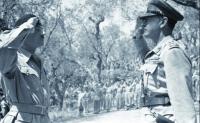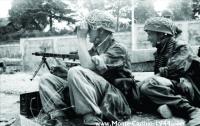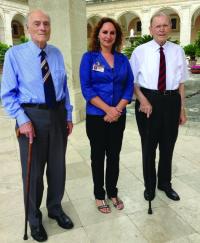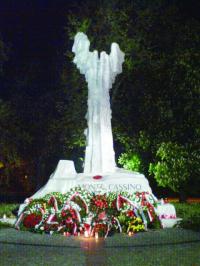
Monte Cassino author Nick Wahoff and view of the Polish Cemetery from Monte Cassino Abbey.

The Germans did not actually occupy the monastery at Monte Cassino and offered to evacuate the priceless art within. The Allies did not believe it was not occupied and bombed it with heavy bombers.

Polish Gen. Wladyslaw Anders (l), cmdr. Second Polish Corps (background), salutes Allied Commander Gen. Sir Harold Alexander (r).

1st Fallschirmjager Div. held Monte Cassino suffering terrible losses in the process.

Two Eighth Army veterans at the Abbey 70 years later.

Monte Cassino Monument at night.
This month, 70 years ago, the Battle of Monte Cassino came to an end. After four costly Allied assaults against heavily fortified German positions, a breakthrough was achieved paving the way for the capture of Rome.
In September 1943 the Western Allies landed at the bottom of the Italian boot. The British, under the command of General Bernard Montgomery, drove up along the Adriatic side of the boot. The Americans, under the command of General Mark Clark, drove up the Western side into the city of Naples. German Field Marshal Albert Kesselring conducted a skillful defense slowing the Allied advance and ending any hope that Rome would fall before the onset of winter. Using the mountainous terrain to their advantage, the Germans inflicted heavy casualties as they withdrew to their winter fortifications – the Gustav Line.
The linchpin of the Gustav Line in the west was the town of Cassino. Dominated by a Benedictine abbey on a mountain with commanding views of the region, Cassino looked over the Liri Valley and was part of the main line of defense to keep the Allies from advancing to Rome.
Built in AD 529 by Benedict of Nursia, the Abbey on Monte Cassino was constructed on an older Temple of Apollo. It was sacked, burned and destroyed by earthquakes over the years, but was rebuilt to become the magnificent structure overlooking the valley and the town of Cassino.
By the middle of January, 1944, the Allies had 18 divisions facing off against 15 German divisions along the heavily fortified Gustav Line.
The initial Allied attacks began on January 17th with the British crossing of the Garigilano River. In response, Field Marshal Kesselring sent two German Panzer Divisions from Rome to stabilize the front. The American assault began on the 20th with the crossing of the Rapido River. With no tanks being able to cross because of the flooded conditions, the Americans were thrown back after a German counterattack.
Other Allied attacks followed with Free French and American troops fighting into the mountains north of Cassino. The US Army was able to reach the base of Monte Cassino, but was fought off by German troops from the slopes below the monastery. After fighting the hard fight, the US 34th Division was withdrawn because of heavy casualties and replaced by New Zealand and Indian troops from the British 8th Army.
As the first battle of Monte Cassino was taking place, the Allies tried to outflank the Gustav Line by landing to the northwest on the beaches of Anzio. While the amphibious assault was a success, the Allies failed to push inland and were rapidly surrounded. The Germans could hold firm in their defensive positions around Cassino since the Allied threat to their rear was contained.
The second battle started with the bombing of the Abbey on Monte Cassino. The Allies thought it would be the perfect German observation post to call in attacks on their forces in the valley below. On February 15, more than 220 Allied bombers dropped 1,150 tons of bombs on the abbey. It was followed by an artillery barrage on the mountain top and an attack by Allied fighter bombers. Actual German positions lower on the mountain and on the hills surrounding Monte Cassino remained untouched. With the destruction of the abbey, the German 1st Parachute Division moved in and turned it into a fortress and observation post.
On the day after the bombing, the British attacked a hill behind the abbey and were thrown back with heavy casualties. The next night British Gurkha units from the Himalayas attacked, but were unsuccessful in their attempt to capture the hill. At the same time, the New Zealanders led a successful assault on the Cassino railroad station, but were later repulsed by a German armor counterattack. The German defenses caused heavy Allied casualties and it would take them nearly a month to regroup and await better weather for the next attack.
On March 15th the third battle began with a three and a half hour bombardment of German positions by heavy bombers and artillery. The Gurkha’s captured a hill only 250 yards from the abbey while the New Zealanders recaptured the Cassino train station. To the surprise of the Allies, the German paratroopers counterattacked preventing any assault on the abbey. With heavy casualties on both sides, the British discontinued their attack.
It took nearly two months of preparation by the Allies before they were prepared for the next battle. Additional troops were sent into the Cassino sector and an elaborate deception was devised by the Allies to convince the Germans of an amphibious landing north of Rome. Field Marshal Kesselring estimated the Allies had six divisions against four of his own. His Axis troops were actually facing 13 divisions.
On the night of May 11th, more than 1,000 artillery pieces began a barrage of German positions around Cassino. The British led the attack by bridging the Rapido River allowing its armor to cross (unlike in the first two battles). At the same time, Polish troops engaged the Germans in the mountains around Cassino in heavy back and forth battles. French mountain troops (the Morrocan Goumiers) outflanked the Germans in terrain thought to be impassable. On May 17th, the Poles launched a second attack on Cassino. Seeing that their supply lines were about to be cut by the Allied advance, the Germans decided to abandon Monte Cassino and retreat to a new defensive line in the rear. Soon after, an exhausted Polish 12th Calvary Regiment planted a Polish flag atop the ruins of the abbey.
With the Germans in retreat, the Allies began their breakout from the Anzio beachhead. Instead of trying to cut off the retreating Germans, U.S. General Clark ordered his troops to go straight to Rome. Less than three weeks after the capture of Monte Cassino, Rome was in the hands of the Allies.
After four major battles, the capture of Monte Cassino had enormous costs for both sides. While the Germans had close to 20,000 killed and wounded, the Allies suffered over 50,000 casualties. The Allied victory at Cassino broke the Gustav Line and led to the fall of the first Axis capital of World War II.
NEXT WEEK: SEVASTOPOL
«Go back to the previous page.





